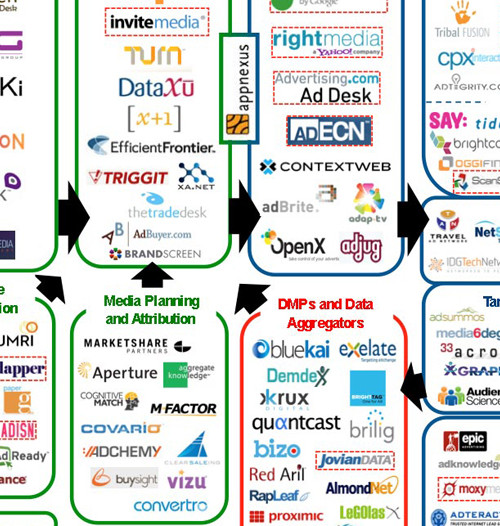When you launch a digital campaign, one of your first priorities is to decide where to purchase your inventory – do you want to buy it directly from your publisher or go through an ad exchange?
This decision is complicated by differing industry views; some claiming that if you want quality placements, buy them directly from a publisher while others observe that savvy marketers should stick to programmatic buying.
Fortunately, digital media acquisition isn’t so black and white anymore. Programmatic approaches can now be used on premium, directly bought media, as well as exchange traded inventory. Below are four techniques for purchasing inventory, all of which help you to deliver against campaign goals.
Direct Buys
Total UK advertising spend is forecast to reach a new high of nearly £14bn in 2013, topping pre-financial crash levels for the first time in six years. Digital will make up almost 50% of total UK ad spend in 2014, Group M is forecasting, reaching £7bn.
Direct buys take the lion’s share of this digital budget, and while we believe these are still an important part of the marketer’s arsenal, they shouldn’t be your main tool. They are useful if your goal is to raise widespread awareness for a product or brand and streamline your message for all readers. However, this approach does not always tailor the message to the unique profile and interests of the user who sees it. With the advancements in the collection and analysis of big data and programmatic technology, this ‘spray and pray’ approach is no longer needed.
Direct Buys with Decisioning
Direct buys that are complimented by a decisioning model are ideally suited for both brand and performance-based campaigns where customised messaging will deliver the best results. This approach goes beyond the traditional weighted rotation of ad creatives and considers the user profile when determining which ad to show. There are two techniques that drive decisioning – programmatic premium and dynamic creative – which can be used separately or in tandem.
Programmatic premium uses first, second and third party data, along with predictive algorithms to infer consumer preferences. Dynamic creative customises ads based on variables captured by the buying platform, such as consumer location.
For example, by using the programmatic premium approach, an auto manufacturer that wanted to target mums with mini-van ads and urban residents with compact model ads could purchase demographic datasets from Nielsen or BlueKai, and overlay it with eXelate ‘auto-intender’ data. This would help to differentiate between women with children and young urban professionals.
With the dynamic creative route, you can apply what you know about your customers to variables captured on the publisher’s sites, such as IP addresses. So, visitors will get ads for their local dealership, based on their IP address.
While this may seem like the most targeted approach, it can be difficult to get the best conversion rates if you don’t have shop fronts in each location your target market lives. In this scenario, you can limit targeting to consumers who are close enough to a store to actually visit it. To do so, you want to buy inventory via a private exchange.
Private Exchanges
Private Exchanges are a great middle ground between premium direct buys and programmatic, auction based buying.
In private exchange scenarios, publishers wall off parts of their inventory and make them available to selected buyers. Buyers pay for this special access to better inventory through higher CPMs, but just like open ad exchanges, you’re not obligated to purchase an available impression if a user doesn’t meet your campaign criteria.
Private exchanges are ideal when a reasonable portion of a publisher’s readership overlaps with your target audience, and the site attracts an adequate number of users to target. But purchasing inventory via a private exchange can get pricey if it doesn’t offer scale you need. In such cases, an open exchange is the best option.
Open Exchanges
If your target audience is relatively small, or can’t easily be found on a national site, the real-time ecosystem is your best bet. Like private exchanges, they can be selective about which impressions you buy, leveraging first, second and third party data to build nuanced profiles of the user behind each impression.
Open ad exchanges are the bread and butter of the real-time bidding revolution. They aggregate inventory from hundreds of publishers of all sizes which means they offer massive scale – billions of impressions reaching 100 million unique users per month
Most ad exchanges have also now implemented exhaustive screening processes that review all inventory to ensure brand safety and to prevent ad clutter.
Most importantly, publishers are beginning to embrace programmatic selling, and are starting to offer premium inventory to the ad exchanges. Some, such as Federated Media, have abandoned their direct sales channel in favor of selling 100% of their inventory programmatically. Still others, with the help of ad-serving platform providers, are figuring out how to centralise their entire inventory into a single location so they determine the best buyer for an impression – a guaranteed campaign, a non-guaranteed campaign, an RTB buyer – the moment an ad call occurs.
So while all quality concerns have been eliminated, you still have a very attractive option to target your ideal audience at scale in the open ad exchanges.
Going back to our opening question – where should you get your inventory for your digital campaigns? The answer lies in your campaign goals.






